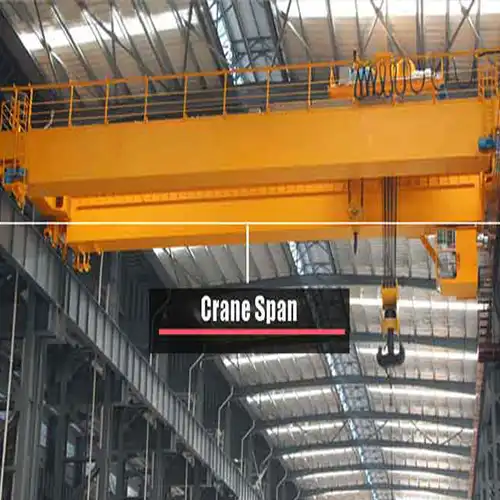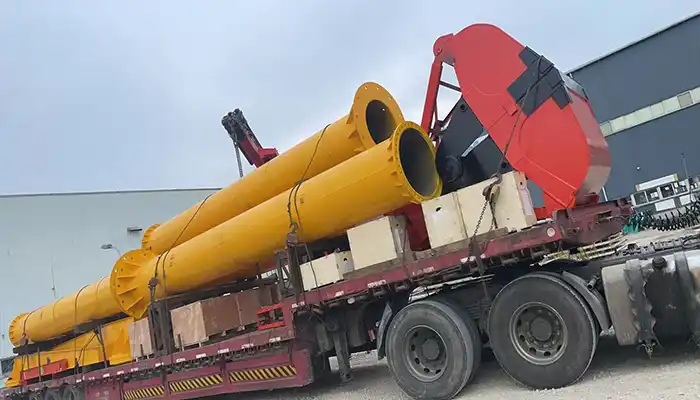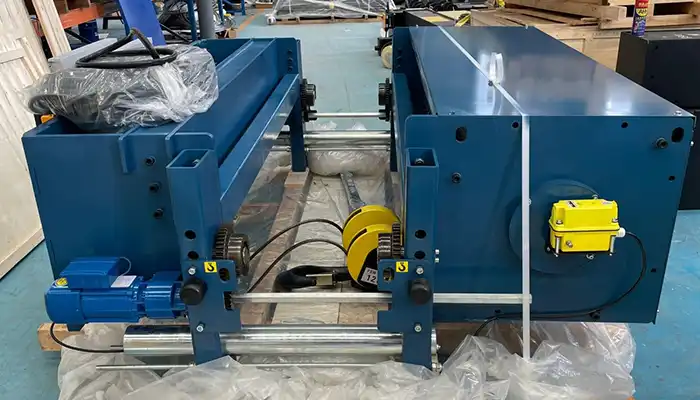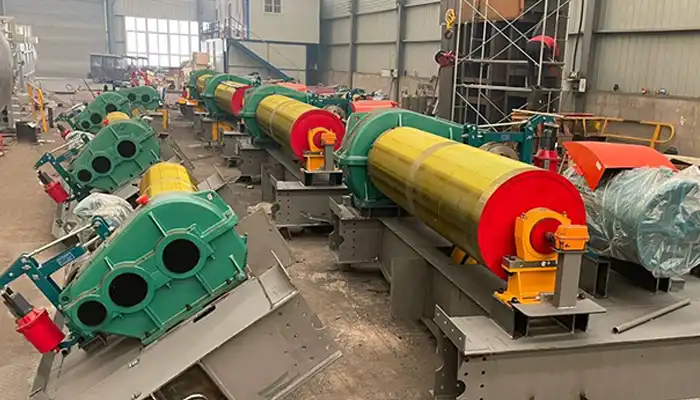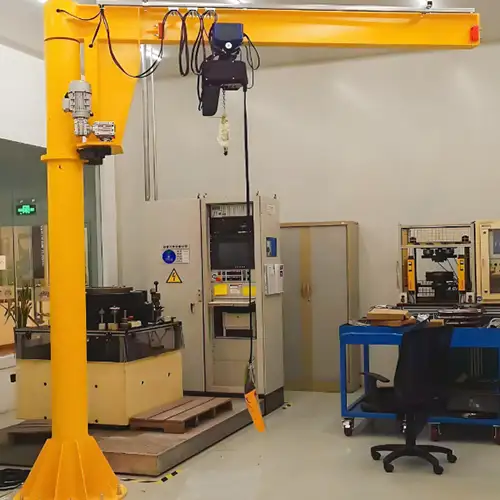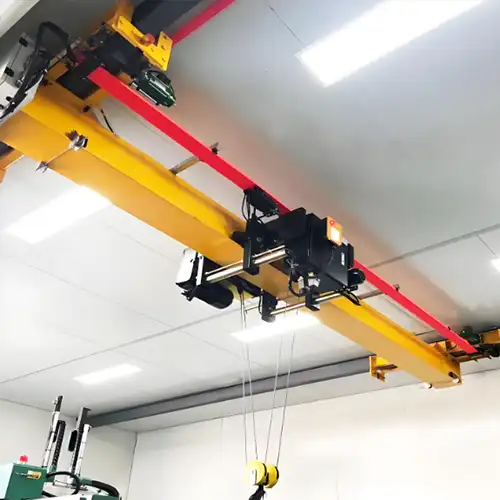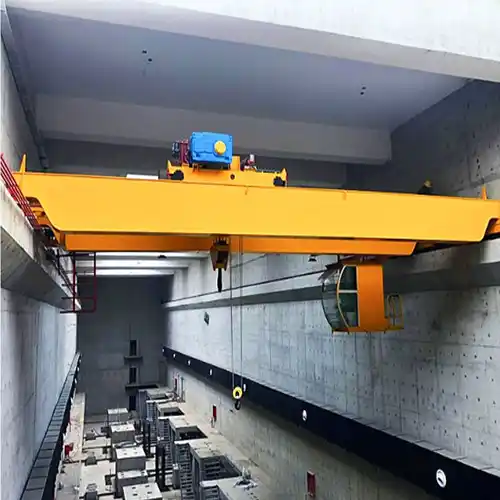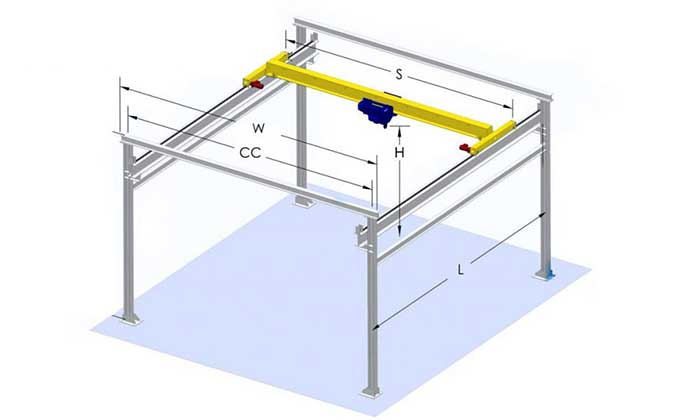Overhead Crane Span Matters! Bridge Crane Beam Length and Costs
Overhead crane span length impacts transport, installation complexity, and overall costs, affecting material, labor, and logistics expenses significantly.
Category: Featured
Your Trusted Overhead Crane Manufacturer & Supplier
Overhead Crane Span Matters! Crane Beam Length and Costs
Crane Span of Overhead Crane
When choosing an overhead crane, the span length is a key factor that influences both the cost and complexity of the entire process. It impacts everything from manufacturing to transportation and installation.
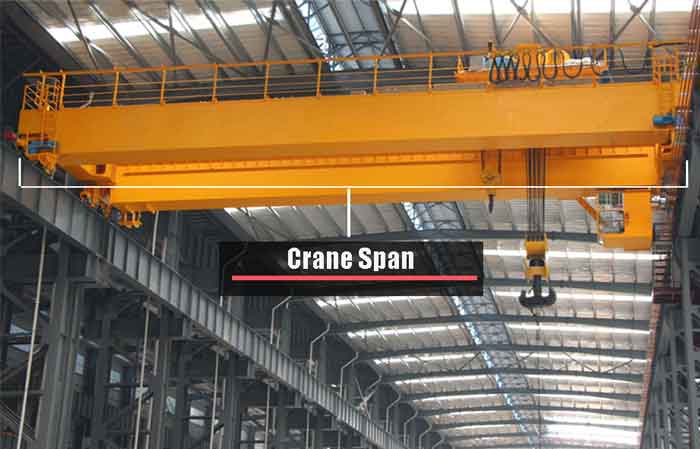
Here's how the span length affects the overhead crane:
- Span length dictates the size of the crane beams and how much material is required.
- Shipping and handling costs increase with longer spans because the beams become larger and harder to transport.
- On-site assembly becomes more challenging with longer spans, requiring more time and specialized equipment.
- Tonnage also plays a part; cranes with higher tonnage require stronger materials and more precise assembly.
In short, the span length of an overhead crane can either save you money or increase costs, depending on how well you plan and manage the logistics. Let’s look into how span length impacts the crane's overall cost and handling in more detail. Click to check more on how to calculate the crane span for your overhead bridge crane
Overhead Crane Costs: Long-Span Cranes Increase Cutting and Shipping Expenses
Increased Material Requirements
When you're dealing with long-span overhead cranes, the materials needed are more substantial. Longer beams require not only more material but also thicker sections to handle the weight and stress. This results in higher steel or metal costs.
- Material Cost Breakdown: As the span increases, the amount of steel or other materials used grows significantly. The larger the span, the stronger and thicker the beams need to be, which increases the total material cost. For example, a 50-ton overhead crane with a 31-meter span will require far more material than a 10-ton overhead crane with an 18-meter span.
- Material Handling: Heavier and bulkier materials not only increase the cost but also complicate logistics at the production facility. Larger materials take more space and need specialized handling equipment, which further drives up costs.
Cutting and Reinforcement Needs
The process of cutting and reinforcing crane beams becomes much more complex when the span is longer.
- Cutting Complexity: Long beams often can't be transported in one piece, so they need to be cut into manageable sections. For example, beams longer than 18 meters may need to be cut into two or more sections, which adds to the labor and machinery costs involved in both the cutting and reassembly processes.
- Reinforcements for Strength: Longer spans require additional reinforcement to ensure the crane remains stable and performs well under load. This means more material is needed for welding, strengthening, and adding reinforcements like joints or cross members. More precision in the cutting and welding process is also required, which demands specialized labor and equipment.
Shipping Costs
Shipping costs are another area where long-span cranes can become expensive.
- Specialized Transportation: The longer and heavier the beams, the more specialized transportation is needed. Standard trucks or flatbeds often can't carry these large beams, requiring custom trailers or even specialized cranes for loading and unloading. Additionally, routes may need to be adjusted, and permits may be required for oversized loads.
- Insurance and Equipment: Shipping long beams also involves additional insurance costs to cover potential damage during transit. The risk is higher with larger beams, so higher premiums are typically necessary. Furthermore, the specialized equipment for loading, securing, and transporting the beams adds to the overall shipping cost.
In essence, longer span overhead cranes lead to higher cutting, reinforcement, and shipping expenses. These increased costs must be considered during the planning and budgeting stages of any crane project.
Crane Span Length: Impact on Transport and Cost
Shorter Spans (<18 meters)
For crane spans shorter than 18 meters, transportation and handling are much simpler and more cost-effective.
- Single-Piece Transport: Shorter beams can often be transported in one piece, eliminating the need for cutting. This reduces labor, material waste, and time spent on the cutting process. Plus, there’s no need to reassemble the beams once they arrive at the installation site.
- Lower Shipping Costs: Since the beams are smaller and lighter, they can be transported on standard trucks without the need for special permits or equipment. This makes the shipping process faster, easier, and significantly cheaper.
- Easier Handling: Handling these beams is more straightforward, meaning fewer cranes or lifting equipment are required, lowering costs at both the transport and installation stages.
In summary, shorter spans are the most affordable when it comes to transport and handling, making them ideal for projects with budget constraints.
Medium Spans (18m to 31m)
For spans between 18 meters and 31 meters, the complexity increases, leading to higher costs.
- Cutting Required: Beams of this size often cannot be transported in one piece, so they need to be cut into two or more sections. This increases material costs, as well as the time and labor required to cut, transport, and reassemble the beams on-site.
- Shipping and Handling Complexity: Shipping becomes more complex because the beams may need to be transported separately, requiring specialized trailers or equipment. It’s also likely that additional permits and logistical coordination are needed to ensure safe transportation. Reassembling the beam sections on-site requires additional labor and equipment, which increases installation time and costs.
- Additional Labor Costs: More workers and cranes are needed to handle these larger sections, and more time is spent aligning and welding the pieces together once they arrive at the site.
In short, medium spans add both material and labor costs, making them more expensive than shorter spans but less so than long spans.
Long Spans (>31 meters)
For spans greater than 31 meters, transport and installation become significantly more challenging and costly.
- Multiple Sections: Long-span beams are very difficult, if not impossible, to transport as one single piece. They usually need to be cut into several sections, which increases both material costs and cutting labor. In some cases, these beams may even require special manufacturing processes to ensure they’re safe for cutting and transport.
- Higher Shipping Costs: Shipping long beams typically requires specialized transport such as custom trailers, cranes for loading and unloading, and sometimes even special routes due to the size of the load. This specialized transport adds significant costs to the overall project.
- Increased Installation Costs: Reassembling long-span beams on-site requires more time, equipment, and workers. The beams must be carefully aligned, welded, and reinforced, which takes precision and labor. The reassembly process also introduces higher risks and complexities, requiring more expertise and planning.
Overall, long spans come with the highest shipping, cutting, and reassembly costs, making them the most expensive option when it comes to transportation and handling.
In summary, the longer the span, the more complex and expensive the transport, cutting, and installation processes become. Shorter spans are cheaper and easier to handle, while medium and long spans require additional cutting, special shipping arrangements, and extra labor, significantly increasing the overall project costs.
Here’s the information in a table format:
| Span Length | Transport & Handling | Costs |
|---|---|---|
| Shorter Spans (<18 meters) | - Can often be transported in one piece. - No cutting or reassembly needed. - Standard trucks used for transport. | - Lower shipping and handling costs. - Minimal labor required. - Reduced installation time. |
| Medium Spans (18m to 31m) | - Beams need to be cut into sections for transport. - Increased shipping complexity. - Reassembly required on-site. | - Higher shipping costs due to more complex logistics. - Increased labor for cutting, transport, and reassembly. |
| Long Spans (>31 meters) | - Beams require multiple sections for transport. - Specialized transport and equipment needed. - Complex reassembly on-site. | - Significant shipping and handling costs due to specialized transport. - High labor costs for reassembly and welding. |
This table gives a clear, concise comparison of how different span lengths impact transport, handling, and overall costs. Click to learn more what affect the overhead crane cost ?
Overhead Crane Tonnage: Larger Capacity, Higher Costs
Impact of Tonnage on Overhead Crane Beam Strength
The tonnage of an overhead crane directly influences the strength and size of the beams needed to support its load.
- Stronger Beams for Higher Load Capacity: As the tonnage of an overhead crane increases, the overhead crane girder beams need to be more robust. For example, a 50-ton overhead crane requires significantly thicker beams made from high-strength steel to safely support the weight it is lifting.
- Material Costs Increase: With higher tonnage, more material is required to build the overhead crane beams. This means that the thicker and stronger the beams need to be, the higher the material costs. For heavy-duty cranes, the increased use of steel and high-grade materials adds to the manufacturing cost.
- Beam Design Adjustments: High-tonnage overhead cranes often use more complex beam designs, such as box girders or double-girder configurations, which are designed to support heavier loads. This design modification leads to greater material costs and, in turn, higher overall crane costs.
In conclusion, overhead cranes with larger tonnages require stronger, thicker beams, pushing material costs higher and making the crane more expensive to build.
Joints and Welding in Overhead Crane Beams
For overhead cranes with long spans, the beams require reinforced joints and more welding, which increases the overall manufacturing and assembly costs.
- Reinforced Joints for Heavy Loads: The joints in overhead crane girder beams need to be designed to handle the high loads and stresses exerted by larger tonnages. This requires stronger joints and additional material for reinforcement. For 50-ton overhead cranes, the connection points between the beams and other components need to be sturdier and more complex.
- Increased Welding Requirements: The welding process becomes more complex for high-tonnage overhead cranes. Multiple layers of welding are often necessary to secure the joints between the crane beams. This ensures that the overhead crane remains structurally sound and capable of supporting heavy loads over time.
- Labor and Specialized Equipment: Welding heavy, reinforced joints in overhead crane beams requires skilled labor and advanced welding equipment. This increases labor costs and requires specialized machinery to complete the job correctly. The more welding needed, the more expensive the overhead crane becomes.
In short, high-tonnage overhead cranes demand stronger joints and more intensive welding, resulting in higher material and labor costs. These additional steps increase both the manufacturing and installation costs of the overhead crane.
As the tonnage of an overhead crane increases, the need for thicker, stronger beams and reinforced joints becomes essential. This results in higher material and labor costs due to the requirement for more robust materials and complex welding processes. Therefore, high-tonnage overhead cranes come with significantly higher costs for production and installation.
On-Site Assembly: The Challenges of Long Span and High Tonnage
Installation Complexity
When it comes to installing long-span and high-tonnage overhead cranes, the complexity of on-site assembly increases significantly. These cranes often require specialized equipment and skilled labor to ensure they are assembled correctly and safely.
- Specialized Lifting Equipment: For long-span cranes, beams can reach lengths of 18 meters or more, making them difficult to handle and position. Specialized lifting equipment, such as heavy-duty cranes, gantries, and hoists, are necessary to lift and position these large components on-site. Without this equipment, the risk of damage to the beams and delays in installation increases.
- Increased Labor and Time: The assembly of long-span, high-tonnage overhead cranes requires more labor and time than smaller cranes. Workers need to carefully position and align each beam section, making sure everything is secure before continuing. This process can take much longer due to the scale and weight of the materials involved. Additionally, the need for multiple workers to handle the beams adds to labor costs.
- Precise Alignment: For the crane to function efficiently and safely, each beam needs to be precisely aligned. Even small misalignments can result in operational issues, such as uneven lifting or excessive wear on the crane’s parts. Installing overhead cranes with large beams and high tonnage requires meticulous attention to detail and the use of precise measuring tools.
In short, the installation of overhead cranes with long spans and high tonnage is labor-intensive and time-consuming. It requires specialized equipment and skilled workers to ensure everything is positioned correctly for optimal crane performance.
Safety and Compliance
Ensuring safety and meeting regulatory standards during the installation of overhead cranes is critical to avoid accidents and ensure the crane’s longevity. High-tonnage, long-span cranes come with increased risks and safety challenges, making it essential to follow safety protocols.
- Adherence to Safety Standards: High-tonnage overhead cranes must meet strict safety regulations to ensure the safety of workers during installation and operation. These standards often include the use of personal protective equipment (PPE), secure rigging practices, and safe lifting techniques. Installing large and heavy beams involves heavy lifting, which poses a greater risk to workers, so maintaining safety measures is crucial.
- Additional Inspections and Certifications: Once the overhead crane is installed, additional inspections are typically required to ensure the crane is up to code and functioning as expected. These inspections are essential for confirming that the crane’s structural integrity, safety mechanisms, and electrical systems are in good condition. Certification from authorized agencies might be necessary to confirm that the crane meets local and international safety standards.
- Compliance Costs: Complying with safety standards and obtaining necessary certifications and inspections may incur additional costs. This can include the cost of safety equipment, hiring qualified inspectors, and covering inspection fees. In some cases, additional repairs or modifications might be required to meet compliance, further driving up the overall cost.
In summary, installing overhead cranes with long spans and high tonnage introduces a range of safety and compliance challenges. Ensuring that everything adheres to safety standards is not only vital for worker safety but also to avoid any legal or operational issues. Additionally, the cost of inspections and certifications should be factored into the overall installation budget.
Conclusion
In conclusion, the crane span length plays a crucial role in determining the overall cost and complexity of transportation, installation, and on-site assembly. Longer spans lead to increased material costs, more complicated cutting processes, and higher shipping expenses. The need for specialized transport and handling equipment also contributes to the overall cost. Additionally, the installation of large, heavy beams requires specialized equipment, more labor, and careful alignment, further adding to the cost and time required.
When considering crane span and tonnage, it’s important to carefully assess your needs to avoid unnecessary expenses. A longer span provides more flexibility, but it comes at a higher cost in terms of transportation, handling, and installation. On the other hand, shorter spans, while potentially limiting some flexibility, offer more cost-effective solutions.
To minimize costs:
- Opt for shorter spans when possible. Shorter spans reduce the need for cutting, specialized transportation, and complicated assembly processes.
- Consider pre-engineered cranes. These solutions are already designed for standard applications and require less customization, leading to lower production and installation costs.
- Plan logistics and installation carefully. Coordinating timely deliveries, ensuring the proper equipment is on-site, and pre-assembling parts when possible can significantly reduce delays and additional costs.
- Consider crane kits without the main girder. If your project allows for it, opting for a crane kit without the main girder can help lower transportation and assembly costs, as you can source the main girder locally or use existing infrastructure.
By making thoughtful decisions about span length, crane configuration, and planning for efficient installation, you can reduce costs and keep your project on track.
Main Projects
Related Products
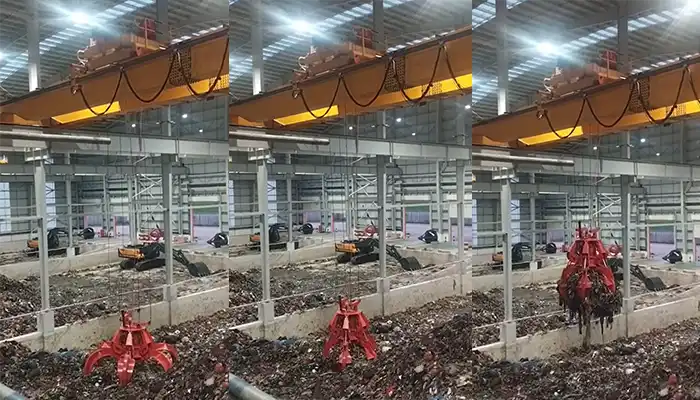
Supplied three grab bucket crane kits to Indonesia, enhancing garbage handling efficiency with high load capacity and reliable performance.
Free consultation to Confirm Parameters & Specifications and Get
Latest Crane Price & Crane Rate.
- Types of overhead cranes : _______?
- Optional: Overhead travelling crane, goliath gantry crane,Slewing jib crane, Single girder or double girder crane,small portable crane or kbk crane, etc.
- Capacity of overhead crane: _______?
- Optional: 0.25ton, 0.5 ton, 1 ton, 2 ton, 3ton, 5 ton, 10 ton,15ton, 20ton, 25 ton, 30ton,35ton, up to 550ton, etc.
- Crane span & lifting height : _______?
- Crane travelling length : _____?
- Control of overhead crane:_______?
- Optional: pendant/ remote/cabin control
- Voltage supply of overhead crane:_____?
- Eg,: 380V50/60HZ,3Phase or others,etc.
- Application/usage of crane:_______?
- Eg,: Steel mill, ,injection mold, cement,stone, concrete,granite, general manufacturing, etc.
Just leave a message via the contact form and our hoist and crane engineer will contact you with in 24working hours.
Get In Touch
